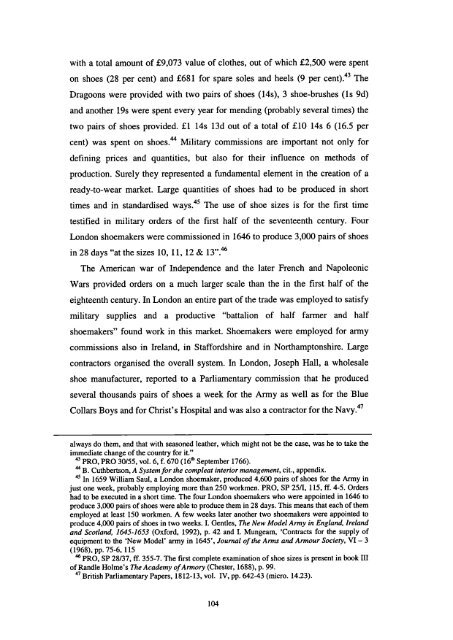The Boot and Shoe Trades in London and Paris in the Long Eighteenth Century
The Boot and Shoe Trades in London and Paris in the Long Eighteenth Century
The Boot and Shoe Trades in London and Paris in the Long Eighteenth Century
Create successful ePaper yourself
Turn your PDF publications into a flip-book with our unique Google optimized e-Paper software.
with a total amount of £9,073 value of clo<strong>the</strong>s, out of which £2,500 were spent<br />
on shoes (28 per cent) <strong>and</strong> £681 for spare soles <strong>and</strong> heels (9 per cent). 43 <strong>The</strong><br />
Dragoons were provided with two pairs of shoes (14s), 3 shoe-brushes (is 9d)<br />
<strong>and</strong> ano<strong>the</strong>r 19s were spent every year for mend<strong>in</strong>g (probably several times) <strong>the</strong><br />
two pairs of shoes provided. £1 14s 13d out of a total of £10 i4s 6 (16.5 per<br />
cent) was spent on shoes. Military commissions are important not only for<br />
def<strong>in</strong><strong>in</strong>g prices <strong>and</strong> quantities, but also for <strong>the</strong>ir <strong>in</strong>fluence on methods of<br />
production. Surely <strong>the</strong>y represented a fundamental element <strong>in</strong> <strong>the</strong> creation of a<br />
ready-to-wear market. Large quantities of shoes had to be produced <strong>in</strong> short<br />
times <strong>and</strong> <strong>in</strong> st<strong>and</strong>ardised ways. 45 <strong>The</strong> use of shoe sizes is for <strong>the</strong> first time<br />
testified <strong>in</strong> military orders of <strong>the</strong> first half of <strong>the</strong> seventeenth century. Four<br />
<strong>London</strong> shoemakers were commissioned <strong>in</strong> 1646 to produce 3,000 pairs of shoes<br />
<strong>in</strong> 28 days "at <strong>the</strong> sizes 10, 11, 12 & 13"."<br />
<strong>The</strong> American war of Independence <strong>and</strong> <strong>the</strong> later French <strong>and</strong> Napoleonic<br />
Wars provided orders on a much larger scale than <strong>the</strong> <strong>in</strong> <strong>the</strong> first half of <strong>the</strong><br />
eighteenth century. In <strong>London</strong> an entire part of <strong>the</strong> trade was employed to satisfy<br />
military supplies <strong>and</strong> a productive "battalion of half farmer <strong>and</strong> half<br />
shoemakers" found work <strong>in</strong> this market. <strong>Shoe</strong>makers were employed for army<br />
commissions also <strong>in</strong> Irel<strong>and</strong>, <strong>in</strong> Staffordshire <strong>and</strong> <strong>in</strong> Northamptonshire. Large<br />
contractors organised <strong>the</strong> overall system. In <strong>London</strong>, Joseph Hall, a wholesale<br />
shoe manufacturer, reported to a Parliamentary commission that he produced<br />
several thous<strong>and</strong>s pairs of shoes a week for <strong>the</strong> Army as well as for <strong>the</strong> Blue<br />
Collars Boys <strong>and</strong> for Christ's Hospital <strong>and</strong> was also a contractor for <strong>the</strong> Navy.47<br />
always do <strong>the</strong>m, <strong>and</strong> that with seasoned lea<strong>the</strong>r, which might not be <strong>the</strong> case, was he to take <strong>the</strong><br />
immediate change of <strong>the</strong> country for it."<br />
PRO, PRO 30/55, vol. 6, f. 670 (16th September 1766).<br />
B. Cuthbertson, A System for <strong>the</strong> compleat <strong>in</strong>terior management, cit., appendix.<br />
In 1659 William Saul, a <strong>London</strong> shoemaker, produced 4,600 pairs of shoes for <strong>the</strong> Army <strong>in</strong><br />
just one week, probably employ<strong>in</strong>g more than 250 workmen. PRO, SP 251!, 115, if. 4-5. Orders<br />
had to be executed <strong>in</strong> a short time. <strong>The</strong> four <strong>London</strong> shoemakers who were appo<strong>in</strong>ted <strong>in</strong> 1646 to<br />
produce 3,000 pairs of shoes were able to produce <strong>the</strong>m <strong>in</strong> 28 days. This means that each of <strong>the</strong>m<br />
employed at least 150 workmen. A few weeks later ano<strong>the</strong>r two shoemakers were appo<strong>in</strong>ted to<br />
produce 4,000 pairs of shoes <strong>in</strong> two weeks. I. Gentles, <strong>The</strong> New Model Army <strong>in</strong> Engl<strong>and</strong>, Irel<strong>and</strong><br />
<strong>and</strong> Scotl<strong>and</strong>, 1645-1653 (Oxford, 1992), p. 42 <strong>and</strong> I. Mungeam, 'Contracts for <strong>the</strong> supply of<br />
equipment to <strong>the</strong> 'New Model' army <strong>in</strong> 1645', Journal of <strong>the</strong> Arms <strong>and</strong> Armour Society, VI - 3<br />
(1968), pp. 75-6, 115<br />
PRO, SP 28/37, if. 355-7. <strong>The</strong> first complete exam<strong>in</strong>ation of shoe sizes is present <strong>in</strong> book HI<br />
of R<strong>and</strong>le Holme's <strong>The</strong> Academy of Armory (Chester, 1688), p. 99.<br />
British Parliamentary Papers, 18 12-13, vol. IV, pp. 642-43 (micro. 14.23).<br />
104


